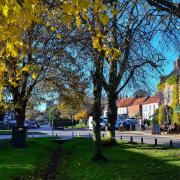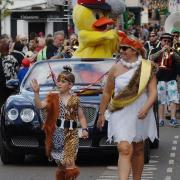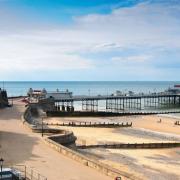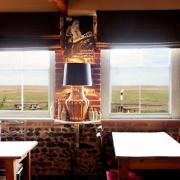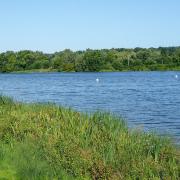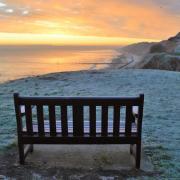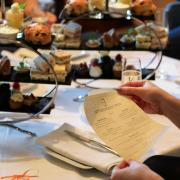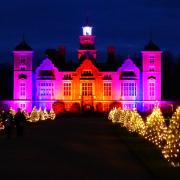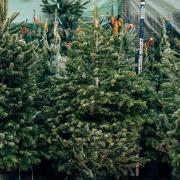The Green Man in churches remains an enigma, writes Marion Welham

Here's a word of caution. Whoever goes in search of the 'Green Man' in Norfolk churches may find themselves drawn into a never-ending quest. The who, when and why of this leafy character, often disgorging leaves and stems from his mouth, nose or even his eyes, has always been elusive.
In Norfolk churches, the Green Man is not always recognisable. You may think you've spotted him when what you've discovered is a woodwose, a mythical wild man wielding a large club, often seen round the base of a font, flanked by lions which he has cowed into submission. It was widely believed he could therefore scare away evil spirits. He's not the Green Man though.
It was Julia Hamilton, Lady Raglan of Monmouthshire, who first coined the name 'Green Man' for the curious carvings on bench ends, corbels, choir stalls, screens and roof bosses. Before that, they were simply 'foliate heads' with origins going back as far as 8th century BC classical Rome and perhaps beyond. When Lady Raglan's folklore article on pagan church symbolism was published in 1939, people began to take notice and to speculate about his origins. Then, when Sir Nikolaus Pevsner, known for his 46-volume The Buildings of England, adopted the name Green Man, it stuck.
But Lady Raglan's claim that foliate heads had been passed down from an ancient pagan tradition together with the May Day figure Jack-in-the-Green was soon dismissed by researchers. After all, where was the evidence for Jack-in-the-Green before the 18th century?

Confusion also arose with pubs called the Green Man, but they only became popular from the 17th century and depicted a forester, a wild man or Robin Hood, rather than the green men found in churches.
And if the Green Man was purely pagan, why was he seen everywhere in European churches from the 11th to the 16th century? Did pagans sneak him into monastic Christian churches? Hardly likely, say researchers, since he is thought to have crossed the channel with the Normans when paganism had been all but wiped out. Magnificent examples from this period can be seen in Norwich Cathedral with green men in all their gilded splendour among more than 1,000 roof bosses.
There are many other wonderful inventions of the medieval mind in churches. Demons and monsters represent the forces of evil or the folly of man, while creatures such as griffins or unicorns were used in churches to tell people how to (or how not to) behave. Green men may have been recruited in a similar way or they may have been purely decorative. For example, a wealthy church patron might well have sat down with an architect or stone mason to choose from a stack of random images to adorn their church. Foliate heads would no doubt have been among them.
The Green Man may have suited the medieval understanding of nature, rebirth and resurrection but those perceptions would have changed some 500 years later when the Gothic revival of the Victorian era saw foliate heads decorating everything from church furnishings to garden ornaments and door knockers.

The Green Man's most recent revival is focused on ecology and our relationship with nature. He has been co-opted for films and festivals, bicycles and breweries, all chiming with Lady Raglan's ideas on his pagan origins. It seems this character can be made to suit our particular needs at any one time.
It's easy to package up the Green Man as a Celtic fertility symbol or a version of a Hindu statue, as some have suggested, but no-one really knows who he is and his appearance varies so much that it's impossible to slot him into a single notion.
The Green Man remains an enigma and a source of fun and fascination. Seek him out in our wonderful Norfolk churches. Make a day of it and prepare to be amazed and amused.

7 places to see a Green Man in Norfolk
Many churches have examples of the Green Man and we've selected seven to discover. You can find out more and plan your days out with the help of the Exploring Norfolk Churches website. Discover churches in your area, find out whether they are wheelchair-friendly, where to park, and the location of toilets and other amenities. exploringnorfolkchurches.org
King's Lynn Minster (St Margaret)
one of the finest examples of the Green Man in Norfolk appears on a misericord - a mercy seat to support monks during long services - at this magnificent Grade I church dating from the 12th century.

Weston Longville All Saints
Look between the spandrels of the sedilia (the seating for senior clergy near the altar) to find this cheery Green Man. All Saints is the church of James Woodforde, the 18th century clergyman famous for his The Diary of a Country Parson.

Sharrington All Saints
You'll have no problem finding the green men in this 13th century church. Twenty corbel heads dominate the roof of the nave, north and south and six green men are joined by animals including a pig, a bat and a happy sheep.

Salle St Peter and St Paul
You may wonder where to start looking in this vast and impressive church. To see green men at close quarters, take the stone staircase to the chapel over the north porch. Here you could be forgiven for thinking a child has been up a ladder carving green men roof bosses from plaster of paris and painting them in gaudy colours.

Thompson St Martin
Green men peer out from the spandrels of the sedilia (the seating for senior clergy near the altar) like the one pictured here. This church, built in 1349 and largely untouched, is full of medieval survivors, including a lovely chancel screen.
Cley St Margaret of Antioch
An early 16th century bench end in between the carved misericords of the choir stalls features this Green Man disgorging stems. This awe-inspiring church dates back to the 14th century with a fine 15th century seven sacrament font and some fascinating stained glass.
Blakeney St Nicholas
You will need to search diligently to find the examples of green men in this beautifully-restored medieval church. Interesting Victorian examples like this one appear on the pulpit as well as the 20th century section of the chancel screen. The chancel itself dates back to 1296 when a Carmelite friary was founded there.




